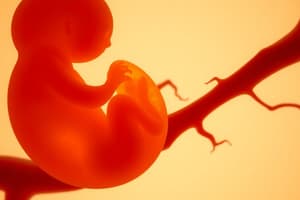Podcast
Questions and Answers
¿Cuál es la secuencia correcta de los estadios del desarrollo embrionario después de la fecundación?
¿Cuál es la secuencia correcta de los estadios del desarrollo embrionario después de la fecundación?
- Cigoto, gástrula, mórula
- Cigoto, mórula, blastocisto (correct)
- Mórula, gástrula, blastocisto
- Blastocisto, mórula, cigoto
¿En qué etapa se forma la gástrula durante el desarrollo embrionario?
¿En qué etapa se forma la gástrula durante el desarrollo embrionario?
- En la implantación del cigoto
- En el periodo inicial o de blástula
- Durante el periodo embrionario (correct)
- Durante el periodo fetal
¿Cuál de las siguientes capas germinales se origina a partir de la gástrula?
¿Cuál de las siguientes capas germinales se origina a partir de la gástrula?
- Capa germinal trofoblástica
- Capa germinal endodérmica (correct)
- Capa germinal mesodérmica (correct)
- Zona pelúcida
¿Cuál es la función principal del blastocele en el desarrollo embrionario?
¿Cuál es la función principal del blastocele en el desarrollo embrionario?
¿Qué ocurre en el proceso de fecundación?
¿Qué ocurre en el proceso de fecundación?
Flashcards
Embryonic Period
Embryonic Period
The stage of prenatal development from fertilization to the formation of a human, encompassing tooth development, from the formation of teeth to their eruption.
Prenatal Development
Prenatal Development
Development of a human from fertilization to birth, divided into stages: initial, embryonic, and fetal stages.
Fertilization
Fertilization
The union of a haploid ovum (egg) and a haploid spermatozoon (sperm) in the fallopian tubes to form a diploid zygote (fertilized egg).
Zygote
Zygote
Signup and view all the flashcards
Implantation
Implantation
Signup and view all the flashcards
Study Notes
1.1 Introduction
- Embryonic period begins at fertilization and lasts until the formation of a human being.
- Teeth develop until they erupt.
- Temporary and permanent teeth combine during this period.
- Tooth parts develop different morphologies & biting forms (occlusion).
- Each tooth has a name or number based on its classification method.
1.2 Human Embryology
-
Studies the prenatal period.
-
Prenatal (embryological) development is divided into three stages:
- Weeks 1-3: Early stage (blastula)
- Weeks 4-8: Embryonic stage
- Weeks 9-40: Fetal stage
-
Fertilization: Union of a haploid ovum & a haploid spermatozoon in the fallopian tube.
-
Results in a diploid cell (zygote) with 46 chromosomes (genetic info from both).
-
Zygote division & movement: Moves through the fallopian tubes to the uterus.
-
Implantation: Implants in the uterine lining (endometrium).
-
Stages of Development:
- Zygote
- Morula (12-32 cell sphere)
- Blastocyst (or blastula)
- Gastrula
-
Blastocyst: Hollow ball of cells with an inner cell mass that creates a cavity (blastocoele) with an outer layer.
-
Gastrulation: Invagination process which creates germ layers (ectoderm, mesoderm, endoderm) which develop into body tissues.
Studying That Suits You
Use AI to generate personalized quizzes and flashcards to suit your learning preferences.




